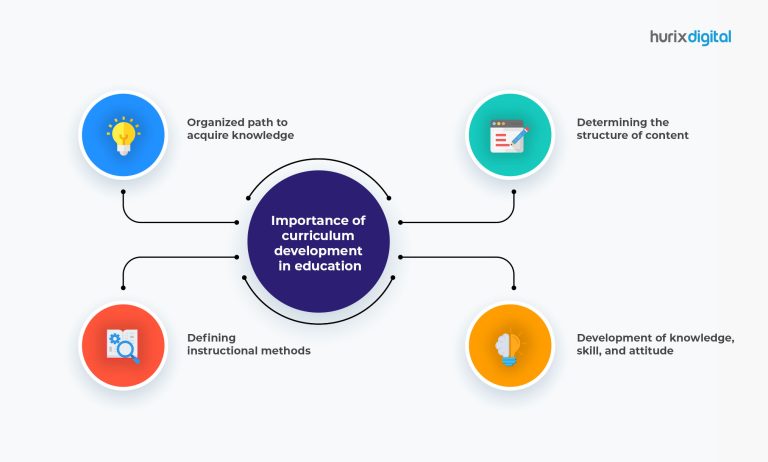Role of Technology in Higher Education Curriculum Development
For any educational institution, the curriculum is the roadmap for both teachers and learners. Curriculum development is a crucial aspect of making a course valuable to learners. It is the framework that provides the foundation to achieve a larger learning goal through suitable teaching methods, learning strategies, and instructional materials.
Table of Contents:
- Importance of curriculum development in education
- How does technology play a role in curriculum development
- How to develop a curriculum for tech-savvy students
- Conclusion
Curriculum development is vital for the selection and organization of appropriate learning material and other activities so that learners can acquire the core competencies of a course. It helps teachers to choose their teaching approach and helps learners to achieve their goals and objectives. So, it is imperative to know what is the role of technology in delivering the curriculum.
While creating the perfect curriculum for students, instructional designers, and educators also need to factor in the role of technology in curriculum delivery in the field of education. Digital learning is the preferred mode of learning for today’s tech-savvy generation. Therefore, higher education institutions are considering the role of technology in delivering curriculum and incorporating digital technology to make their curriculum more relatable and engaging.
Importance of Curriculum Development in Education

- Organized path to acquire knowledge: The main purpose of the curriculum is to provide an achievable learning framework that helps students to acquire knowledge. To make the wide spectrum of knowledge acquirable and understandable for learners, educational institutions have divided it into subjects and organized them in an engaging learning model.
- Determining the structure of content: All subject matter needs to be represented in an acquirable form to the learners according to their learning capability. The development of a curriculum helps in determining the structure of the subject matter for a particular level of teaching.
- Defining instructional methods: Curriculum development helps to determine a student-centric instructional method that makes the subject interesting to the learners.
- Development of knowledge, skill, and attitude: A curriculum provides the framework for developing knowledge and skills along with enhancing creative ability.
How Does Technology Play a Role in Curriculum Development
The role of technology in curriculum development in higher education has revolutionized the learning process. Incorporating technology in the curriculum offers a dynamic as well as collaborative learning experience to students. For the tech-savvy Gen Z students, technology means not only quick access to a broad spectrum of knowledge, but also an interesting way of learning.
The use of technology in higher education such as digital learning platforms and interactive multimedia is already improving classroom engagement and educational outcomes. Implementing interactive learning features, quizzes, simulations, gamification, and so on in an educational curriculum can improve the motivation, performance, and achievements of learners.
Higher education institutions must focus on creating a need-based curriculum for students, with the help of smart education apps and AI-based programs. Embedding technology in the educational curriculum can help students learn in a better and effective manner.
How to Develop a Curriculum For Tech-Savvy Students
In the present scenario, when textbooks are getting replaced by laptops or tablets, and backboards are giving way to smart boards, it has become essential to reform the curriculum for tech-savvy students and develop a new curriculum that embeds digital technologies. Many higher education institutions now realize the potential role of information technology in curriculum collaborating with IT and software organizations to develop smart learning apps and tools to integrate technologies into their curriculum. The aim is to provide students with instant access to a wide spectrum of knowledge and various types of learning materials. Some of the changes that higher education institutions can incorporate when it comes to developing a curriculum for tech-savvy students are:
- Developing and providing eLearning content
- Developing learning videos and audiobooks
- Incorporation of online lectures and interactive lessons for flipped learning
- Leveraging simulation and gamification to make the learning process engaging
- Use of learning software for better understanding
- Use of course management software for better collaboration
- Implementation of online collaboration and broadcasting tools to make the courses accessible from anywhere
- Adoption of cloud-based applications (such as – Learning management system) for the better learning experience
For online or hybrid higher education programs, it is essential to have all study materials available online. Many institutions have already incorporated measures to facilitate a digitized learning infrastructure, such as the preparation of a course outline with due dates, planning of assignments for evaluation of learners’ knowledge, creation of online quizzes, and so on. In short, the implementation of technology in the curriculum needs the collaborative effort of all teaching facilitators, institutional heads, and governing bodies. Some educational institutions are already using advanced technologies to improve the student learning experience. For instance, Temple University has implemented a chatbot to answer common and frequently asked questions by students.
With a thoughtful and seamless integration of technology in the curriculum, students will not only have a better learning experience, but the role of teachers will also evolve. Effective technology integration in the learning process will change classroom dynamics. Today’s tech-savvy students are comfortable with smart campus concepts, where they can freely interact with smart devices and accumulate knowledge whenever and wherever they want. To facilitate this concept of active learning, educators prepare online lectures and interactive lessons (Flipped Classrooms concept) that students can access anytime.
Similarly, Active Learning Forum is one of the collaborative distance learning platforms on which both the educators and students virtually collaborate, and participate in a face-to-face learning process like a regular classroom, but all interactions occur remotely. Institutes like the University of Minnesota and North Carolina State University have been successful at running Active Learning Classrooms to facilitate learning activities. All these approaches are meant to make the learning experience more engaging for the tech-savvy generation.
Several higher education institutions are currently focusing on the importance of technology and curriculum, and finding new ways to incorporate technology into their coursework. Some are also providing laptops or tablets and free internet connection on the campus to encourage learners.The present scenario requires educational institutions to embrace the role of technology in delivering the curriculum and making it engaging and beneficial for today’s tech-savvy students. To bring about an effective reformation in curriculum designing, all concerned individuals, including teachers, instructors, institution heads, and government authorities, should put in efforts in a progressive way.
Since the needs of students change with time and advancements in technology, gradual upgradation of the curriculum is essential. Technology integration is a vital step to make learning effective and collaborative, which in turn will make students future-ready.
Frequently Asked Questions (FAQs)
1. How can technology be integrated into the curriculum development process?
A. The curriculum development process can incorporate technology by selecting digital learning resources, adopting online and blended learning models, utilizing educational software and applications, and integrating emerging technologies such as virtual reality, artificial intelligence, and data analytics.
2. How can technology support active and experiential learning in higher education?
A. In higher education, technology facilitates active and experiential learning through interactive simulations, virtual labs, online discussion platforms, multimedia content, and real-time collaboration tools.
3. Can technology help address the needs of diverse learners in higher education?
A. Technology in higher education can cater to diverse learners by offering accessibility features for students with disabilities, delivering content through various modalities, and supporting differentiated instruction based on individual learning styles, preferences, and abilities.
4. How can technology be used to prepare students for the digital workplace?
A. To equip students for the digital workplace, technology can be integrated into the curriculum with industry-relevant software, simulations, and case studies. This fosters the development of digital literacy, virtual work experience, and practical familiarity with future career tools and technologies.
5. How can technology be effectively evaluated and assessed in higher education curriculum development?
A. The evaluation of technology in higher education involves gathering feedback from students and faculty, conducting usability testing, monitoring learning analytics, and aligning technology usage with learning outcomes.

Senior Vice President – APAC
A Business Development professional with >20 years of experience with strong capability to sell new solutions and develop new markets from scratch. New Market Entry Specialist with experience of working in two of the largest emerging markets – China & India. Also covered other key markets in APAC & ME. Exceptional experience of conceptualizing, ideating and selling new learning technologies like VR AR, etc. across multiple industry verticals.









